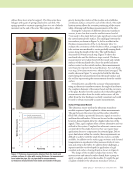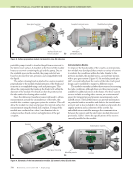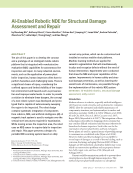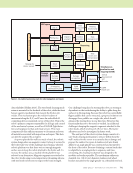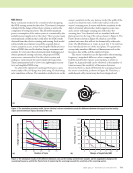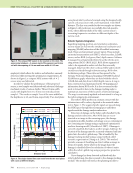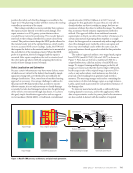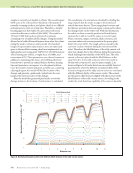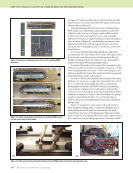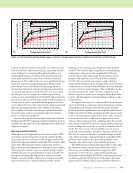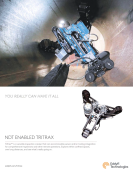728 M A T E R I A L S E V A L U A T I O N • J U L Y 2 0 2 1 ME TECHNICAL PAPER w A B S T R A C T Fossil fuel power plants are complex systems containing multiple components that require periodic health monitoring. Failures in these systems can lead to increased downtime for the plant, reduction of power, and significant cost for repairs. Inspections of the plant’s superheater tubes are typically manual, laborious, and extremely time- consuming. This is due to their small diameter size (between 1.3 and 7.6 cm) and the coiled structure of the tubing. In addition, the tubes are often stacked close to each other, limiting access for external inspection. This paper presents the development and testing of an electrically powered pipe crawler that can navigate inside 5 cm diameter tubes and provide an assessment of their health. The crawler utilizes peristaltic motion within the tubes via inter- connected modules for gripping and extending. The modular nature of the system allows it to traverse through straight sections and multiple 90° and 180° bends. Additional modules in the system include an ultrasonic sensor for tube thickness measurements, as well as environmental sensors, a light detecting and ranging (LiDAR) sensor, and camera. These modules utilize a gear system that allows for 360° rotation and provides a means to inspect the entire internal circumference of the tubes. KEYWORDS: internal pipe crawler, robotics, inspection, superheater tubes Introduction The power generation of a superheater power plant relies on burning coal to boil water and convert it to steam. The super- heated steam, produced in the combustion chamber, is directed to the turbines of the plant to generate electricity by converting the kinetic energy of the fluid into electrical energy. The combustion chamber contains numerous pipes, typically found in a coiled structure, that operate at tempera- tures up to 540 °C and pressures between 10 to 1000 bar. In addition, the tubes range from 1.3 to 7.6 cm in diameter (Dehnavi et al. 2017). These tubes are located in the hottest region of the steam generator and can fail if maintenance and inspections are conducted infrequently. Prolonged operation can result in the rupture of critical components, stemming from plastic deformation and surface oxidation (Abraham et al. 2018). To avoid failure, an inspection of the superheater tubes should be done periodically. Typically, these inspections are conducted externally, and are often manual and time- consuming. They are also challenging, as some areas are diffi- cult to reach and the environment can be dangerous for humans. Recently, robotic inspections have seen an increase in utilization as an alternative to human-based examinations (Nayak and Pradhan 2014). One approach using robotic inspections is to conduct the evaluation on the external surface of the pipes or tubes (Kapayeva et al. 2017). These devices (Shang et al. 2008 Balaguer et al. 2000 La Rosa et al. 2002 Longo and Muscato 2004 Tavakoli et al. 2013 Park et al. 2002) crawl on the external surface of the tubes using different adhesion mechanisms including suction (Longo and Muscato 2004), thrust propellers, and magnets (Tavakoli et al. 2013). These systems can detect pinholes, cracks, and thick- ness reduction due to erosion and corrosion using sensors such as electromagnetic acoustic transducers (Park et al. 2002) and other nondestructive tools. Although some of the technical issues with external systems have been addressed, there are still some challenges that need to be investigated. This includes the potential diffi- culty of navigating on pipes with limited external access. An example includes boiler superheater tubes, which are often stacked and do not allow for the external inspection of the tubes inside the combustion chamber. Internal inspection systems offer an alternative to the more conventional external approach. These systems do not have issues with the external constraints but have their own challenges due to the reduced Development of an Innovative Inspection Tool for Superheater Tubes in Fossil Fuel Power Plants by Caique Lara†, Julie Villamil†, Anthony Abrahao†, Aparna Aravelli†, Guilherme Daldegan†, Sharif Sarker†, Daniel Martinez‡, and Dwayne McDaniel* Materials Evaluation 79 (7): 728–738 https://doi.org/10.32548/2021.me-04212 ©2021 American Society for Nondestructive Testing † Mechanical and Materials Engineering Applied Research Center, Florida International University ‡ George W. Woodruff School of Mechanical Engineering, Georgia Institute of Technology * Mechanical and Materials Engineering Applied Research Center, Florida International University mcdaniel@fiu.edu
J U L Y 2 0 2 1 • M A T E R I A L S E V A L U A T I O N 729 availability of space. They also can require the system to be shut down prior to the inspection. Several designs and concepts for in-pipe inspection systems have been discussed in the literature (Hadi et al. 2020 Kishi et al. 2015 Tesen et al. 2013 Omori et al. 2009 Debenest et al. 2014 Nagase et al. 2013 Ito et al. 2019 Gargade and Ohol 2016 Boxerbaum et al. 2012 Qiao et al. 2013 Yeo 2012 Nagase et al. 2016). These systems perform a variety of tasks including internal cleaning of ducts (Ito et al. 2019), measurement of surface thickness, mapping of tubes, and visual inspection (Gargade and Ohol 2016). One of the significant challenges for internal crawler systems is the ability to generate traction within the limited space of the tubes. Earthworm-type robots (Boxerbaum et al. 2012 Qiao et al. 2013) offer larger traction output, but require a number of degrees of freedom. Wheeled (Yeo 2012) and treaded (Nagase et al. 2016) systems offer simpler designs but generate less traction. The compromise between maneuverability and design simplicity is a major challenge in developing a robotic inspection system. However, there is little research that has been conducted on the development of internal crawlers for superheater tubes and small-diameter pipes in general. This is likely due to the limited space avail- able and the coiled nature of the tubes. In this paper, a novel robotic inspection tool is presented that can navigate through small-diameter pipes and provide information on the structural integrity of tubes typically found in power plant superheaters. The system consists of a tethered pipe crawler that can navigate through coiled tubes with 180° bends and diameters as small as 5 cm. The primary crawler will contain modules that house inspection sensors including a light detecting and ranging (LiDAR) sensor, environmental sensors, cameras, and an ultrasonic sensor for measuring tube thickness. Multiple auxiliary crawlers will also be utilized for load distribution of the tether as the system navigates through the multiple bends and straight sections. A schematic of the concept is shown in Figure 1. Robotic Crawler Movement of the crawler is generated using a set of gripper and extender modules that propel the crawler forward using peristaltic motion, similar to earthworms that travel by Crawler Auxiliary crawler Auxiliary crawler Camera Camera Instrumentation module Extenders Tether Tether Superheater header access point Superheater coil Coil connection Flexible links Grippers Crawler Auxiliary crawlers Entry point Deploying tool Figure 1. Conceptual design of the crawler inspection system.
ASNT grants non-exclusive, non-transferable license of this material to . All rights reserved. © ASNT 2025. To report unauthorized use, contact: customersupport@asnt.org






















































































